Can India be at the cusp of a new capex cycle
Mutual Fund
Introduction
The productive capacity of an economy is acquired from the fixed assets formation in its industries. Capital expenditure (Capex) is incurred when a business entity invests to capture additional market opportunities. Long term economic growth takes place when such capital expenditure is undertaken for new projects, or for expansion, modernization or diversification of business activity. Thus, it can be said that capital expenditure is a barometer of economic development of a country.
History of Capex Spending in India
India’s capex history can be divided into 4 phases. In each of the four phases public spending (Government projects) have formed the bedrock of investments on which private spends have expanded on over the last few years.
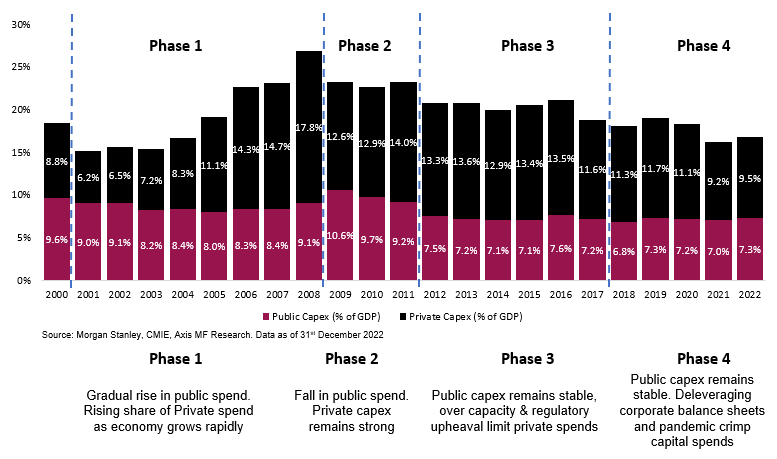
Notably, like today, post a bevy of domestic reforms, capex investments across sectors saw the best expansionary period during pre-Global Financial Crises (GFC) years - A period like no other in India's investment history. As India rode the global bull cycle, its real GDP growth stayed close to 8% for a five-year period ending with the global financial crisis (FY04-FY08). Importantly, it was a unique period in India’s investment growth history where compounded annualized growth rate (CAGR) for all key sectors reached their respective all-time highs.
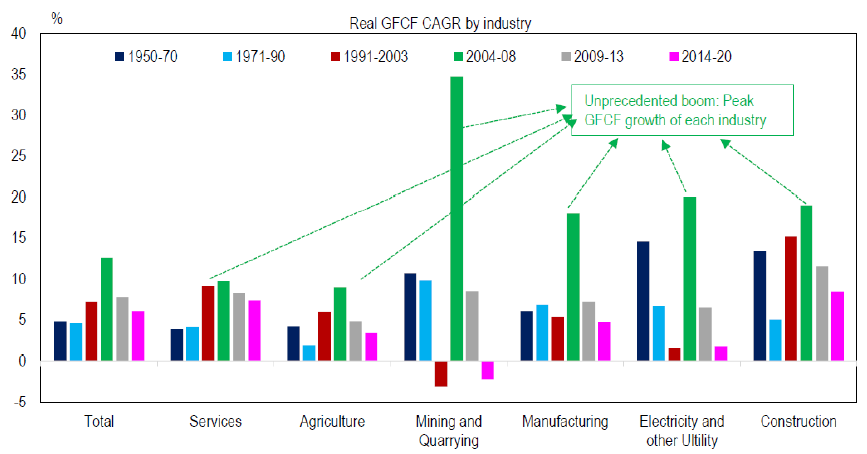
Source: Citi India, Axis MF Research. Sectors mentioned above are for illustrative purposes only.
Case for a repeat of 2004-2008? Significant Government Impetus
The Indian government has been steadily increasing its capital expenditure as policy makers realized the need for high quality sustainable infrastructure to improve the efficiency of operations in India and become globally competitive. Since 2014, central & state governments have been systematically increasing infrastructure. While the Centre focuses on multi-state developmental projects, the states target granular city/district level projects piggy backing off central projects to provide last mile capabilities.
Improved tax collections have resulted in increased feasibility of such a large capex cycle. Further synergies of GST and higher tax compliance have resulted in significant benefits for the government. Cumulative commitment on infra spends outlined is ~US$ 1.8 Tn across 14,728 projects(Source: India Investment Grid)
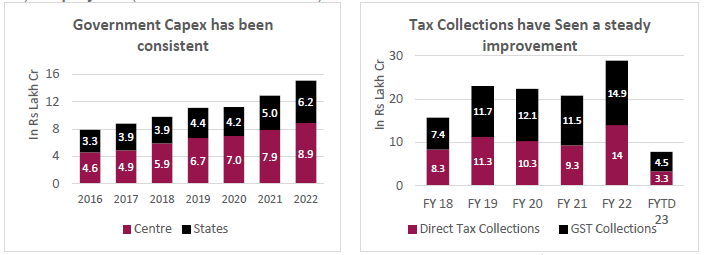
Source: RBI, Budget Documents. Ministry of Finance, Axis MF Research. Data as of 31st December 2022
The central government in collaboration with the states has thus far identified 4 major nodes in its grand infrastructure plan
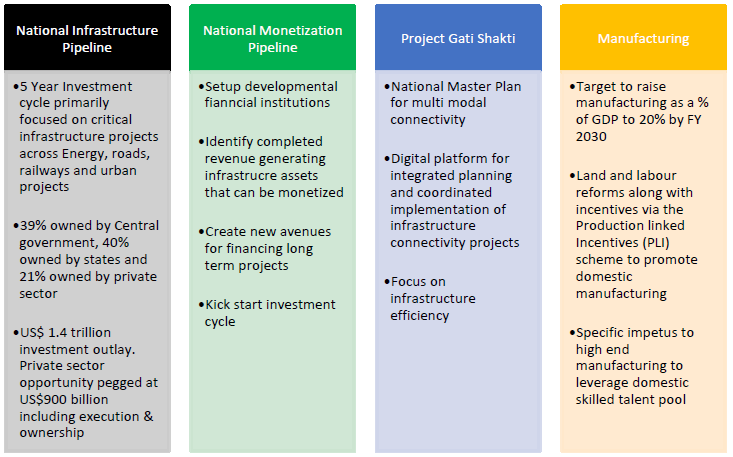
Source: india.gov, Axis MF Research
Current Investment Opportunity Set
Raw Material & Building Products
Any capital expenditure requires the use of raw materials. Typically, nationwide capex cycles would result in exponentially large demand for raw materials like metal, building material & machinery. These companies are often the first winners of a capex business cycle. Companies that supply commodities & raw materials are able to implement larger production cycles at short notice and capitalize on near term supply chain gaps by increasing prices. The resulting profitability creates shareholder value. The fragmented nature of the competition and often localized nature of the business are key challenges to companies in these sectors. The commoditized nature of products implies limited product differentiation and are high price sensitivity. Super normal profits if any, are often short lived as players’ jostle of market share by under cutting competition.
Manufacturing & Design Services
Implementation of projects is the most specialized and time consuming element of any project. Highly skilled labour and reputable business partners are the norm while executing economically sensitive projects. Equipment manufacturers also are crucial cogs in the entire implementation process. Companies with a proven track record of executing projects and providing relevant services are natural beneficiaries. For government projects, lengthy tendering processes and political uncertainty can often raise costs of project implementation especially turn-key projects. Long gestation cycles for such projects also means that companies need to be financially as well as technologically capable of managing large projects.
India’s Commitment to Climate action
India is the 3rd largest greenhouse gas (GHG) emitter in the world, behind the US & China. Five sectors – energy, agriculture, industry, transportation & infrastructure – contribute to more than 96% of India’s GHG emissions today.
India’s net zero transition will need an ambitious multi-decade effort to transform each of these sectors.
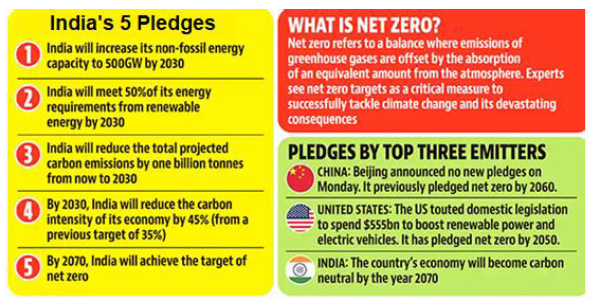
How to Play the Capex Cycle?
As an investor, the onset of a capex cycle can be a strong driver of wealth creation. This is on account of 2 reasons, very high short term growth on account of a low base & Beta. Companies that typically benefit in a capex cycle can be categorized into 3 buckets

Most companies catering to this segment are scattered across the Indian large, mid and small cap space. Due to the large number of participants and the complex nature of such an opportunity, active management is key to identifying companies best positioned to capitalize on their niche sectoral opportunities. A capex cycle is typically mirrored by a secular equity bull cycle. However, companies that execute projects profitably ultimately add share holder value. Multi-cap & thematic strategies are ideally positioned to capture long term opportunities.
Disclaimer
Source of Data: Axis MF Research, Bloomberg.
This document represents the views of Axis Asset Management Co. Ltd. and must not be taken as the basis for an investment decision. Neither Axis Mutual Fund, Axis Mutual Fund Trustee Limited nor Axis Asset Management Company Limited, its Directors or associates shall be liable for any damages including lost revenue or lost profits that may arise from the use of the information contained herein. No representation or warranty is made as to the accuracy, completeness or fairness of the information and opinions contained herein. The material is prepared for general communication and should not be treated as research report. The data used in this material is obtained by Raw Material and building Products Manufacturing & Design Services Enablers of Capex Axis AMC from the sources which it considers reliable.
While utmost care has been exercised while preparing this document, Axis AMC does not warrant the completeness or accuracy of the information and disclaims all liabilities, losses and damages arising out of the use of this information. Investors are requested to consult their financial, tax and other advisors before taking any investment decision(s). The AMC reserves the right to make modifications and alterations to this statement as may be required from time to time.
Axis Mutual Fund has been established as a Trust under the Indian Trusts Act, 1882, sponsored by Axis Bank Ltd. (liability restricted to Rs. 1 Lakh). Trustee: Axis Mutual Fund Trustee Ltd. Investment Manager: Axis Asset Management Co. Ltd. (the AMC) Risk Factors: Axis Bank Limited is not liable or responsible for any loss or shortfall resulting from the operation of the scheme.
(Mutual Fund investments are subject to market risks, read all scheme related documents carefully.)
MUTUAL FUND TOOLS & CALCULATORS
Recent News
-
Mr. Navneet Munot's 'Person of the Year 2025'
Dec 31, 2025
-
The Wealth Company Mutual Fund Receives SEBI Approval to Launch Specialized Investment Fund SIF
Nov 26, 2025
-
Axis Mutual Fund Launches Axis Multi Asset Active FoF Fund of Fund: A One Stop Solution for Dynamic Asset Allocation
Nov 21, 2025
-
The Wealth Company Mutual Fund makes record debut with four active NFOs, garners close to Rs 2000CR
Oct 29, 2025
-
Axis MF Launches Axis Income Plus Arbitrage Passive FOF
Oct 28, 2025







